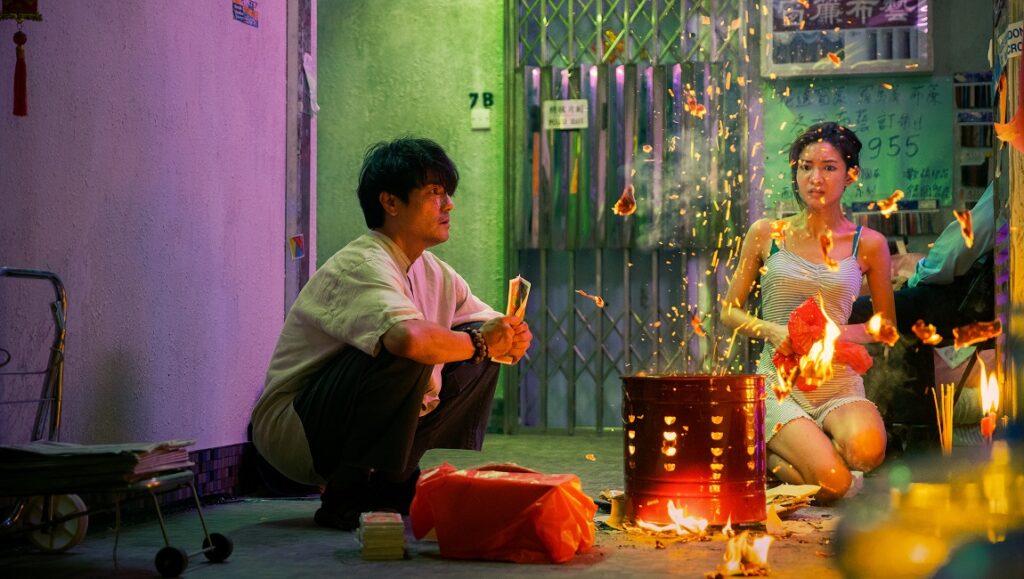Hong Kong auteur Soi Cheang is a modern B-movie master whose works have dipped into an assortment of subgenres. Cheang’s aesthetic language is in constant flux, and has undergone drastic reformulation across his filmography. For instance, his early horror masterwork New Blood (2002) and more recent martial arts hit SPL II: A Time for Consequences (2015) share a passion for visceral and audacious images, yet their means to this end are completely different. In Limbo (2021), Cheang’s Hong Kong is an inner-city swamp built from overflowing heaps of garbage and disembodied limbs. The city becomes a festering wound, shot in ghostly, digital black-and-white, and jam-packed with visceral olfactory imagery. Now comes Mad Fate, which reteams Cheang with frequent Jonnie To collaborators (To himself also produces) for a film that’s semantically similar to Limbo yet syntactically antithetical. Inevitably, Mad Fate steps into the shadow of Limbo; both films are violent serial killer stories, assembled with a crossover cast and crew, and both premiered at Berlinale, two years separated. But while Mad Fate offers some tonal revisions to Cheang’s aesthetic approach, those come almost entirely in support of a less singular and nuanced work.
Mad Fate begins (and peaks) with an Argento-esque narrative set-up: Two protagonists witness the latest in a string of sex worker killings, and by either coincidence or fate (an ambiguous duality the film foregrounds), arrive at the victim’s door simultaneously. One is a young delivery driver (Lokman Yeung), given to a nascent inclination towards violence which he mostly unleashes on street cats. The other is a middle-aged fortune teller (the great Gordon Lam), tumbling deeper into delusion as he wages war against the finality of fate. Inside the victim’s apartment, the two men find the woman stabbed to death and suspended, via chains, under glowing purple lights. However, all pretense of a standard serial killer mystery evaporates as the delivery driver proceeds to giddily splash about in the puddles of blood left behind by the deceased, like a sadistic Gene Kelly. From here on, Mad Fate’s serial killer narrative becomes mostly backdrop; instead, Cheang centers the dynamic of his plot around his two unstable protagonists, who band together to confront the reality of their uniquely deteriorating psyches.
Continuing Limbo‘s portrait of a tormented Hong Kong full of hapless souls, each character in Mad Fate grapples with past traumas. Cheang’s movies recognize a universal suffering that unites an otherwise incongruous cast of characters around a shared abyss of misery. That said, while Limbo is relentlessly grim — really, the bleakest of genre filmmaking — Mad Fate’s anguish is punctured by an unexpected kookiness. The two men here descend into increasingly idiosyncratic states, soundtracked by baffling needle drops including “Colonel Bogey March” and Beethoven’s 9th, twice each. There’s even an uncanny, recurring CGI cat that seems better suited to The Monkey King series (Cheang’s foray into Mainland blockbuster filmmaking). And the violence in Mad Fate (of which there’s plenty) is imbued with head-scratching levity; there are so many wounds and there’s so much bloodshed in the film, but it’s by-and-large dramatically inconsequential. While the sadness which permeates most of Cheang’s films usually feels genuine and sincere, here it’s primarily a catalyst to an inconsistently funny and absurdist scenario.
Mad Fate’s projection of its world — a spiritual Hong Kong, ravaged by apocalyptic climate eruptions — isn’t without creativity. The movie is most dialed-in when its gaze wanders away from flesh-and-blood characters, capturing surrounding dramas that span from the minuscule to the cosmic—from ants writhing in a single raindrop to the brooding, warping skies overhead (which stand-in as a perceived barometer of God’s will). Indeed, the sky is a constant presence in Mad Fate, often frenzied and roaring behind the action via green screen. And DP Cheng Siu-Keung — whose work last year on Wai Ka-fai’s Detective vs. Sleuths was staggering — seems uncharacteristically uninspired; his compositions lack depth and, despite the increasingly extreme material, fail to deliver suitably explosive energy. Mad Fate is admirable as another stark reinvention for the ever-changing Cheang, though this time it’s not an entirely welcome one.
DIRECTOR: Soi Cheang; CAST: Lam Ka-tung, Lokman Yeung, Berg Ng, Peter Chan Charm-man; DISTRIBUTOR: ILLUME Films; IN THEATERS: August 11; RUNTIME: 1 hr. 48 min.
Originally published as part of InRO Weekly — Volume 1, Issue 7.5.


Comments are closed.